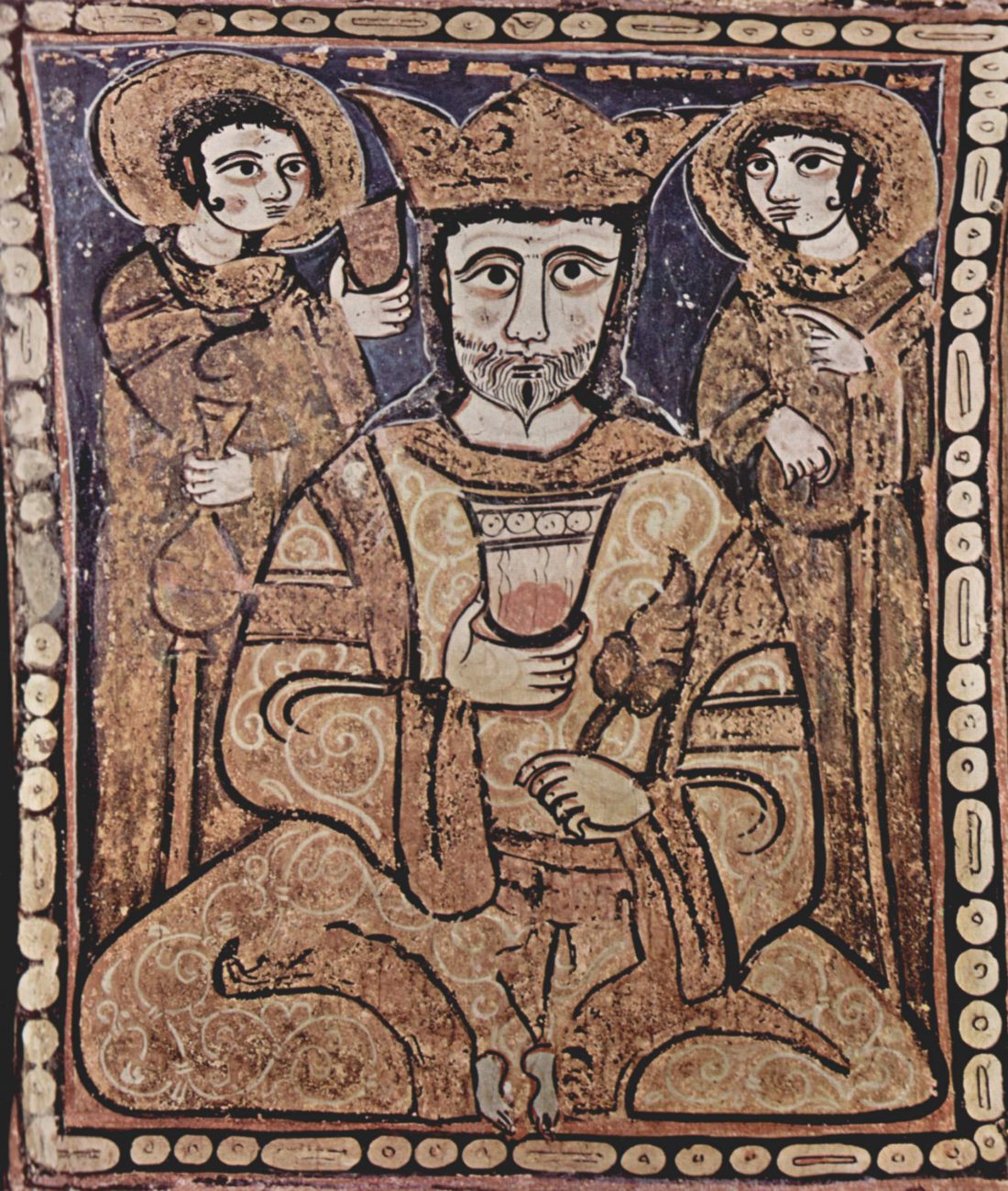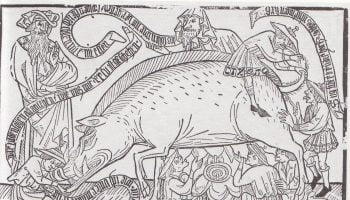This is Part X of The Public Medievalist’s continuing series on Race, Racism and the Middle Ages, by Luca Asmonti.
Go back to the beginning of the series here.
In 1059, Pope Nicholas II did something a bit odd: he crowned Robert Guiscard, a Northern French adventurer of Norse extraction, Count of Sicily, Apulia, and Calabria. However, Sicily was, at that time, under Arab control. It had been for over two centuries. The laborious process of conquest of the island by the Normans took almost thirty years; Palermo fell in 1072, as Trapani did in 1077, and Syracuse in 1086. The last Sicilian city to capitulate to the Normans was Noto; by 1089, the history of Siqilliyat—the Arabic word for Arab-ruled Sicily—had come to an end.
Sicily was under Arabic control for more than two centuries. At the height of Arabic Sicily in the early ninth century, Palermo was a prosperous city of about 100,000 souls, and the ruling emir maintained an elegant and learned court. By the end of Siqilliyat, Palermo became known as the city of five hundred mosques, and the Arabs had introduced cotton and citrus to the island. For those who enjoy Limoncello, you can thank the Arab rulers of Sicily.
The legacy of Arab rule would shape the island’s culture and identity for much longer than those two hundred. But, somewhat like ancient Sparta, Arabic Sicily appears like a ‘mirage’ which we can only see through the eyes of others—be they the Norman conquerors, or the diasporic daughters and sons of Siqilliyat who left after it had fallen into the hands of the Northern invaders.
The most famous of the wandering sons of Siqilliyat is the poet Ibn Hamdis. Ibn Hamdis is a man whose gorgeous, heartbreaking poetry has resonated throughout the ages, and stands as among the greatest poetry of his, or any, age. And more, his poetry resonates in distinct harmony with other poets of the Mediterranean, revealing to us a world far more linked than we have been led to believe.
A Poet of Exile
Ibn Hamdis was born either in Syracuse or Noto around 1055, a scion of an important house of the southeastern region of Sicily known as the Val di Noto. When he was still in his early twenties, Ibn Hamdis decided to leave Sicily with his wife, seeking a career as a court poet—particularly as a panegyrist, one who specializes in eulogies.
In Seville, Spain, he was welcomed at the court of the Abbadid prince Muhammad al-Muʿtamid, a man celebrated for his magnanimity and literary proclivities. But when Seville was taken by the Almoravids in 1091, Ibn Hamdis migrated to Africa. He then spent time at the Zirid court of Mahdiya, in present-day Tunisia, in Bijaya, the seat of the Algerian house of the Hammadids, and in Aghmat, Morocco. In the final years of his life, Ibn Hamdis lived in Majorca, where he died around 1133.
The main themes of the Diwan—the poetic corpus of work—of Ibn Hamdis are the virtues of his patrons and, most importantly, of Sicily: the lost glory of Muslim Siqilliyat and the joyful world of the poet’s youth.
In the following verses, the poet mourns the past valour of his homeland, remembering the glory days of the Muslim conquest:
Oh, Sicily! Destiny has deceived her
and she had protected the people of her time
How many are the eyes made sleepless by fear
that had been lulled to sleep by safety?
I see my nation—the Christians have imposed disgrace upon it
when once its glory was firmly established by my people
And the nation of infidels was once clothed in fear of her,
but now she is clad in the armor of fear of them
I no longer see the Arab lions among them
and in their hands you would see the unbelievers become prey
Oh my eye, you have not seen their like—squadrons
of war heroes in battle trampling their enemy.
How many a shining sword! You imagine them
radiant shooting stars in the thick of the night
Standing out among the sword-edges of the armored warriors
he cuts the helmets from the horsemen
I never imagined that the heat of fire might cool
when it falls upon the palm leaves in the arid heat of summer.
But Siqilliyat was not just the terrain for fierce battles. The island nostalgically remembered by Ibn Hamdis was also a veritable Paradise.
I remember Sicily, as agony
Stirs in my soul remembrances of her.
An abode for the pleasures of my youth, now vacated,
Once inhabited by the noblest of people.
For I have been banished from Paradise,
And I [long to] tell you its story.
Were it not for the saltiness of tears
I would imagine my tears as rivers.
I laughed at twenty out of youthful passion;
Now I cry at sixty for her crimes.
Do not exacerbate my faults on your own account,
Since God never ceases to forgive them.
The theme of al-hanın ila lawtan, nostalgia for one’s homeland, was a typical theme in pre-Islamic poetic style qasida (‘odes’). This was part of a wider repertoire of traditional motifs, themes, and images, which constituted the toolkit of the professional panegyrist of the Arabic Middle Ages. In this case, the poet is not mourning a lost person, but a lost place and time.
A Poet of a Changing World
Certainly, the Sicily described by the poet featured a number of stylized elements which were first and foremost intended to satisfy the literary fantasies of his audience. The eleventh century was a difficult one for many Muslim empires, as power shifted and fragmented. The literary echoes of the golden Age of Arabic culture and power was consoling and validating for many who found themselves within a world in conflict.
That being said, Ibn Hamdis’ meditations on war, nostalgia and exile, as well as on his own personal experiences, places him within a broader Mediterranean poetic tradition.
The central themes of Ibn Hamdis’ verses—war and nostalgia—are also the key ideas which inspired Homer’s, The Iliad and The Odyssey. Even more intriguingly, the literary persona of Ibn Hamdis, who defines himself by the woes of exile, and the longing for a homeland which has lost its power and dignity—bears extraordinary resemblances with some of great lyric poets of ancient Greece.
Take Theognis of Megara (from the sixth century BC). He also was a member of his city’s aristocracy, who also had to endure the humiliation of exile, and of a wandering life far from home. He wrote:
I have heard the shrill voice of the bird, son of Polypaus, which is come to tell mankind to plough in season; and it hath smitten my heart black to think that others possess my flowery fields, nor for me do the mules draw the yoke of the plough, by reason of this most hateful voyage.
Like the verses of Ibn Hamdis, Theognis’ art intertwines the passions and sorrows of exile with those of waning youth, and impending old age:
Love himself riseth in due season, when the earth swelleth and bloweth with the flowers of Spring; ay, then cometh Love from Cyprus’ beauteous isle with joy for man throughout the world.
A Poet of The Sicilian Heart
Mediterranean poets also had a distinctive way of writing about the finer things in life. Some of the most distinctive elements of Mediterranean culture are two environments: the banquet and the garden. These spaces were devoted to what the Romans called otium: leisure time devoted to conversation, friendship, and self-improvement.
In the Palatine Chapel of Palermo, there is an extraordinary example of this. The vaulted ceiling of this twelfth-century Norman Chapel was made in an Arabic style—a muqarnas—that is better seen than described:




Painted onto this muqarnas are powerful images of this enchanted world of otium. Each tiny niche in the ceiling is populated by hunting princes, singing bards and, believe it or not, wine-drinking revelers. For wine is the flavor and essence of this refined Mediterranean world, as Ibn Hamdis knew very well:
A youth who has studied wine until he knows
The prime of the wines, and their vintage
He counts for any kind of wine you wish
Its age, and he knows the wine merchant.
Expanding on this, in a famous essay published in 1969, “Sicilia e sicilitudine” (“Sicily and Sicilitude”), Italian writer Leonardo Sciascia described the unique abilities of the best Sicilian authors. They are able to observe and describe the life of their homeland with such vigour and intensity that their stories become immediately relevant to a universal audience.

Strategically placed at the heart of the Mediterranean, the history and identity of Sicily were defined by this centrality. The island thus attracted the appetites of ambitious outside powers, leaving it vulnerable and uncertain, as successive waves of foreign masters came and went. This was never as true as it was during the Middle Ages. And, this is why in order to understand the richness and complexity of those centuries, there is arguably no better place to start than Sicily. Ibn Hamdis, the Arabic poet who loved wine and the pleasures of life, is the perfect product of that land rich of surprises and contradictions.
A Poet of the Mediterranean
Thus, to fully appreciate the importance of Ibn Hamdis, we should change our perspective; we should see him as a Mediterranean poet rather than an Arabic one. Adopting this Mediterranean perspective is essential—it dismantles the myth of the “Whites only” medieval world, and better captures the true complexity of those crucial centuries.
Reading Ibn Hamdis is important. It helps us to challenge the dominant view of the Mediterranean Sea as a spatial boundary between a North and a South, and between development and backwardness. It challenges the idea of the Middle Ages as a temporal hiatus between the classical age and the time of its rediscovery. Ibn Hamdis shows us the bonds among the cultures of the Mediterranean. He shows us the unity of a world which we tend to fragment with superimposed notions of North and South, East and West, Muslim and Christian.
The Public Medievalist does not pay to promote these articles, so we would love it if you shared this with your history-loving friends! Click to share with your friends on Facebook, or on Twitter.





Very well written I will finish reading it it seems very interesting